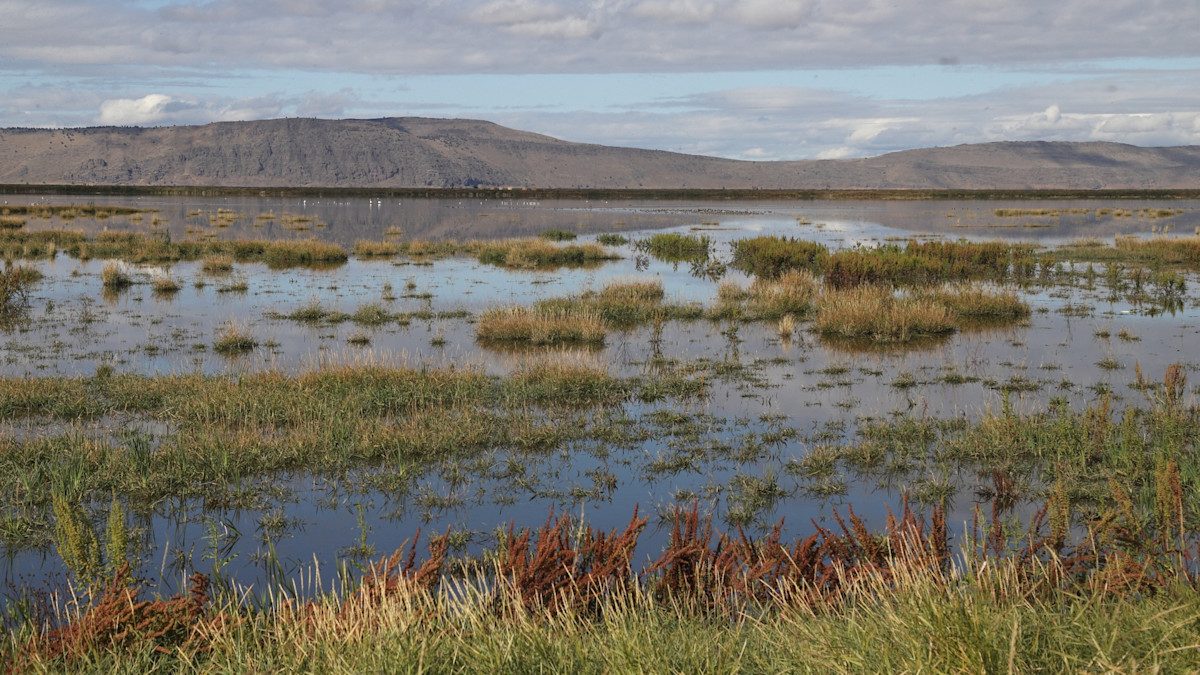
Waterfowl in the Klamath Basin have been hit with a one-two punch of avian botulism and bird flu. So far, at least 5,000 birds have been found dead as a result. The Klamath Basin National Wildlife Refuge Complex is comprised of six wildlife refuges across Southern Oregon and Northern California. The target of this recent disease outbreak is the Tule Lake Refuge, located in California, on the southern end of the refuge system.
The Klamath Basin Refuge Complex serves as a vital feeding and breeding ground for tens of thousands of birds in the Pacific Flyway. Over 75% of the region has been converted to agriculture, leaving these wetlands as a solace for migrating birds. But a key factor in the health and success of wetlands is ensuring that they do, in fact, remain wet—well, most of the time, that is. Having enough water in the area not only keeps birds happy and well-fed; it also mitigates the diseases that have so far killed thousands of waterfowl.
“Wetlands are designed to temporarily go dry, it’s actually beneficial to them in many ways,” Fish and Wildlife Service Biologist for the Klamath Basin Refuge Complex, John Vradenburg, told MeatEater for a previous article. “But the problem we see with this sustained drought in the Klamath, is the more they dry out, you lose the carbon storage ability of the wetlands, then subsidence of the highly organic material, then you lose that vegetative structure that made it so important to water birds originally.”
The Klamath Basin is no stranger to water issues. Two years ago, Teddy Roosevelt’s first National Wildlife Refuge went bone dry. Dam removal on the Klamath has been a hot topic in the news in attempts to restore struggling salmon and steelhead populations. And at the top of the watershed, the Upper Klamath Lake must maintain a certain level of water in order to ensure the survival of endangered c’waam and koptu suckers—species that are found only in the area and vitally important to Klamath tribes.
The core issue plaguing the region—and much of the rest of the country—is prolonged drought.
The impacts of this long-term water shortage came to an ugly head in 2020 when 60,000 ducks, geese, and shorebirds died from a botulism outbreak. According to the USGS, avian botulism is caused by the soil bacterium Clostridium botulinum, which causes paralysis and death in birds. Birds can become infected with botulism after ingesting decaying organic matter or live invertebrates that have been infected with the toxin.
Two types of botulism have been found in birds: Type C, which occurs during warmer months across the U.S., and Type E, which is found primarily in the Great Lakes. While these types of botulism have not been shown to impact humans, its effects are devastating on our feathered friends.
“Death by avian botulism is gruesome. Poisoned birds lose their ability to walk, then to control their wings. Unable to hold up their heads, poisoned ducks often drown in the water that should have given them life,” Jefferson Public Radio reported in 2020.
This recent outbreak started with the discovery of avian bird flu (H5N1) in a few hundred dead and dying eared grebes. Researchers determined that the culmination of decomposing bird carcasses in drying wetlands with shallow, warm waters created a perfect storm for botulism breeding grounds.
The devastation of 2020 was a learning lesson for managers of the refuge system, and they now know that the best way to deal with an outbreak like this is to stop it before it starts. Unfortunately, the cart is already rolling down the hill in this scenario. The best means of hitting the brakes? More water.
Waterfowl advocates like Ducks Unlimited, California Waterfowl Association, and Klamath Water Users Association (KWUA) have all called on the Bureau of Reclamation to divert water to the refuges immediately to minimize the damage of this botulism outbreak. Colder water temperatures could slow the growth and spread of the botulism bacterium, while more water availability would allow birds to disperse over a larger area—which would also help mitigate the spread of the bird flu.
Where would this water come from? The Upper Klamath Lake. Luckily, this last spring was a wet one. While there is typically more demand than availability of water in the lake this time of year, the level is one foot above the end-of-season threshold required by the U.S. Fish and Wildlife Service’s analysis. It’s crucial the water doesn’t go below the established threshold because it supports the endangered suckers in the lake, salmon in the rivers, crops in the field, and waterfowl in the wetlands. Every aspect of this region needs water, and it’s meticulously allocated to provide some semblance of balance. The amount of water needed to make an impact in the wetlands would lower the overall level by about an inch.
Like most wildlife management issues, there is no simple, short-term solution to this problem; water allocation amidst drought is a convoluted issue where fragile ecosystem needs must be balanced between agricultural demand and water availability.
But folks are actively seeking solutions. In fact, this last spring, the Bureau of Reclamation diverted additional water to the refuges to avoid creating unsafe conditions while dam removal on the Klamath River is underway. It resulted in “the highest and most diverse waterbird population we’ve had on Tule Lake in three or four decades,” according to Vradenburg.
Cooling seasonal temperatures should also help slow the progress of botulism, and the overall success of the wetlands this year indicates that populations won’t be seriously impacted.
“The wetlands are extremely productive right now, and they should be even better next year as water quality continues to improve,” Vradenburg said. “There’s good stuff happening along with the bad stuff.”





